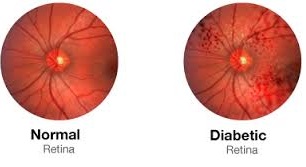What is Retina?
The retina is the light-sensitive layer of tissue at the back of the inner eye. It acts like the film in a camera. Images come through the eyes lens and are focused on the retina.

The central portion of the retina is called the macula. This area is extremely important for fine vision hence damage to it can cause permanent blindness. The Retina is normally red due to its rich blood supply.
How Diabetes affects retina?
Damage to the retina is called Retinopathy which can eventually lead to blindness. Diabetic Retinopathy occurs when diabetes damages the tiny blood vessels in the retina.
The longer the duration of diabetes and poorer the control of Blood sugars more is the chance of developing diabetic retinopathy. Other risk factors which can lead to diabetic retinopathy are High Blood pressure, High Cholesterol, Pregnancy and Tobacco use.

Initially Diabetic retinopathy may not show any symptoms, as the condition progresses it may show symptoms which include Spots or floaters, flashes of light, Blurred vision and impaired colour vision.
Can Diabetic retinopathy be prevented?
You can’t always prevent diabetic retinopathy. However, regular eye examination, good control of your blood sugar and blood pressure, and early intervention for vision problems can help prevent severe vision loss and reduce the severity of Diabetic Retinopathy.
How often should eye checkup be done in people who have diabetes?
If you have diabetes, it’s very important that you do eye check-up once a year. The earlier the retinopathy is detected, the greater the chance of preventing complications and vision loss.

